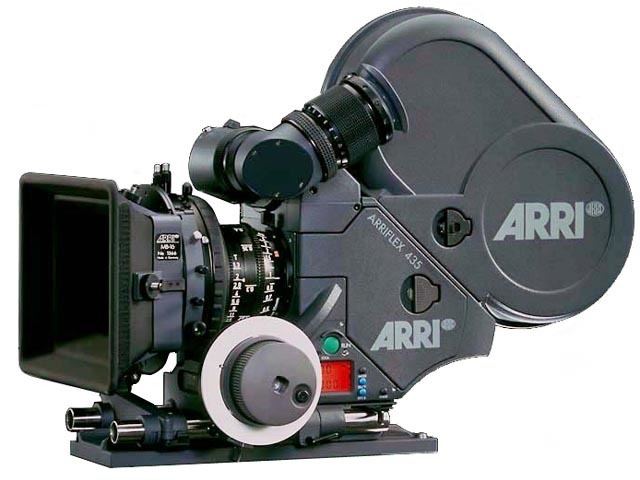Gauge 35 mm | ||
 | ||
Introduced 1995 (435 and ES), 2001 (Advanced), 2004 (Xtreme) Movement Five link with dual registration pins and pulldown claws, 3 or 4-perf pulldown | ||
The Arriflex 435 is a movie camera product line created by Arri in 1995 to replace the Arriflex 35III line. The number reflects its position as a successor camera to the Arri III and the fact that it is designed for 35 mm film. The 435 cameras are specifically designed as MOS cameras, which means that they are conventionally considered to be too loud to record usable location sound. However, this also frees the camera up to be optimized for non-sync sound uses, particularly any filming which either doesn't require sound or shooting at non-sync speed, shooting in reverse, or ramping between different speeds. As such, its potential applications are widespread, and thus it is regularly used on music videos, commercials, second unit work on features, special effects work, and motion control, among other usage. It is currently considered to be the most popular 35 mm movie camera in usage, due to its wide range of production adoption, intuitive design, high reliability, and retail availability. Rival Panavision even owns more 435s for rental than Arri's own hire houses; Panavisions, however, can be converted to Pan-Arri 435s where they are modified to accept Panavision lenses and accessories. In recognition of the achievements of the 435 system, AMPAS awarded Arri a Scientific and Engineering Academy Award in 1999.
Contents
Models and technical data
(Most of the specifications noted apply forward to all successive models unless noted otherwise.)
435 and 435ES
Arri debuted two models of the 435 in 1995: the 435 and 435ES. The latter is suffixed ES to denote electronic shutter capabilities; this means that the shutter angle is able to be continuously electronically adjusted, even while the camera is running, and set to any angle within a specific range (11.2° to 180°) to a great deal of precision (0.1°). Otherwise, they are identical in all other respects. These include a standard Arri PL mount; compatibility with Super 35; frame rates adjustable both in forward and reverse between 1 and 150 frames per second, accurate to .001 frames per second; fixed-loop magazines and backwards compatibility with older Arri magazines; compatibility with some Arriflex 535 accessories; timecode capability; and a highly flexible viewfinder and video-tap system which could be switched out with other video tap options.
Other accessories and capabilities were modularly added in successive years, including Steadicam magazines (1996), an integrated video assist (1997), 1,000-foot (300 m) magazines and single frame control (1998), and 3-perf movement (2000).
435 Advanced
The 435 Advanced was unveiled in 2001 and was the result of several years of feedback from users of the 435 system. While not only making standard some of the improved accessories made available in the interim, the 435 Advanced added more features to increase the versatility of the camera. These included a lower minimum frame rate of 0.1 frames per second, motion control integration with Arrimotion, and LDS (Lens Data System) lens recognition capability through electronic sensors.
435 Xtreme
A new FEM (Functional Expansion Module) was added in 2003 to increase the camera's electronic feature set. Arri integrated this into the new 435 Xtreme, which was released in 2004. The new functions included faster ramping speed capability, a wider ramping range which could go down to 0.1 frames per second, further motion control interface abilities, integrated lens electronics, and integrated wireless radio signalling.
Three more accessories were released in 2005, exclusively for the 435 Advanced and 435 Xtreme: a hand-crank extension, a timing shift box to offset the phasing, and a remote LCD control panel designed for use on the "dumb side" of the camera.
